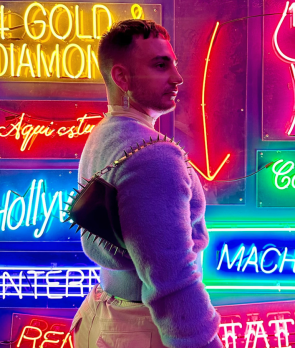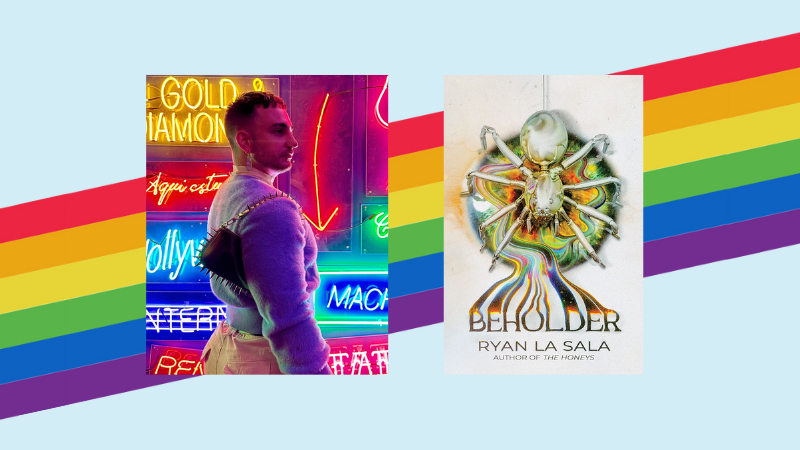 Ryan La Sala’s Beholder is a story about seeing and being seen – and the cost of looking. As it blazes a path to the darkest corners of our minds, the YA horror novel intertwines death and destruction with style and sophistication, making readers question our preconceived ideas about what and who we can trust, the belief systems we’ve inherited, and the stories we tell ourselves. In celebration of Pride Month, we caught up with Ryan, the reigning king of queer horror, about what inspired him and what he wants readers to know.
Ryan La Sala’s Beholder is a story about seeing and being seen – and the cost of looking. As it blazes a path to the darkest corners of our minds, the YA horror novel intertwines death and destruction with style and sophistication, making readers question our preconceived ideas about what and who we can trust, the belief systems we’ve inherited, and the stories we tell ourselves. In celebration of Pride Month, we caught up with Ryan, the reigning king of queer horror, about what inspired him and what he wants readers to know.
What inspired Beholder?
Beautiful things in nature are often poisonous, but what about the beautiful things in our homes? While at a party in a NYC penthouse, I kept getting distracted by the room’s strange wallpaper and the many tiny mirrors peering at me from the walls, and I thought of The Yellow Wallpaper by Charlotte Perkins Gilman. In the singular room of that story, a wallpaper is so ugly it drives a woman mad. What if the wallpaper surrounding me held a similar psychic poison? What if it closed itself over the doors and spread across the windows, and smothered us inside its terrible, beautiful claustrophobia? And as I thought about this--fully ignoring the people talking around me--a dead little girl ran through the room! I’m not even kidding. I grabbed the man next to me and asked, “Did anyone else see that dead little girl?” and he said, “That was my daughter.” He was the host. I politely excused myself, went home, and wrote everything down. It’s now the opening scene of BEHOLDER.
 You often write about queer main characters facing the supernatural. What draws you to queer horror?
You often write about queer main characters facing the supernatural. What draws you to queer horror?
Queer people are, in my opinion, perfect protagonists for scary stories (really all stories, I’d say). Many of us have a hyper-honed sense for danger. We have had to survive threats that look dubiously normal to every eye but ours. And we understand that monstrosity is a shifting concept. As a teen, I had to understand what made a monster so that I could stop society from making a monster of me. I learned that horror, just like beauty, is in the eye of the beholder, and it has given me many books-worth of trauma to write about.
The New York City art world is dazzling and notoriously exclusive. Why did you choose to focus on art, and particularly the NYC scene?
Oh, because if there is ever a secret society hidden in plain sight, it’s the lovingly impenetrable art world. And if anyone is going to unwittingly let an eldritch serial killer get away with literal murder, it’s going to be rich artsy people who have never once questioned their own taste or their own vulnerability. Duh!! The cultivated aloofness of the art world speaks to my own fixation around esoteric practices, and clandestine society, and secret spaces all throughout NYC that are only ever a wall away from real life, but accessible to only a select few. When I find myself in those spaces--an art gallery, or a dazzling home, or a too-expensive restaurant--I can’t help but stare at the people and wonder: “Who? Who are you? And why are you hiding in here?”
Beholder pays a lot of attention to design, and especially wallpaper. What made you want to explore the spaces we inhabit in this way?
In the Victorian era, wallpaper was made with arsenic to make the colors pop. The result? People were slowly sickened by the beauty of their rooms. I love the idea of a cage so beautiful that we cannot see it. Doesn’t that describe so many subtle, spatial manipulations? Designers and architects use all sorts of tricks to guide us, like naive marbles, through buildings and rooms. I wanted to explore the magic of this, which isn’t magic at all. We just call it interior design.
Why did you choose to write this story from two points of view?
Beholder is a conversation between Athan, the charming, charismatic lead, and his reflection. It’s a dark reflection he refuses to look at--has been warned to never look at by his superstitious grandmother. I wanted to give the thing lurking in the reflection a voice, and I wrote this point of view in second person to evoke the voice of an intrusive thought. We all have that voice, telling us: you don’t look right today, your friends don’t really like you, you should stick your finger in the outlet below the mirror. Just try it. Don’t you just want to try it? Athan has these intrusive thoughts, except much worse. And they’re not just thoughts, as it turns out. They are the very thing hunting him, that his Yiayia rightfully warned him to never look for.
Athan’s relationships, particularly with Dom and his yiayia, are so critical to his understanding of himself. What did you want to convey about how he sees himself, and the importance of having other perspectives to get the full picture?
Did you know that the color of something--like a red apple--is because the thing itself absorbs all colors except the one it reflects? The red apple is anything but red. Keeping that in mind, you must think of Athan as a rainbow. He is so determined to be seen as good, as charming, as effortlessly fun, that he shows up as every color. Whatever you want to see, really. And for a while this works, until he meets Dom--a young artist who instantly rips away Athan’s rainbow veil out of necessity. They must survive, and to do so Athan is going to have to finally face who he is when he isn’t lit by the light of other people’s expectations. I don’t think there’s anything scarier, if I’m honest. But the lesson here is one I cherish: the people around us reflect us, so take care to find people who reflect a version of yourself that you love.
The book explores the complexities of guilt and grief, with an honest look at how we use coping and defense mechanisms. What do you want readers who may be dealing with their own challenges or traumas to take away from this story?
Grief and guilt are so strange--we all have them in common, yet they are completely individual experiences. No one can tell you how to get through it, but everyone will tell you that there is something waiting on the other side. I always realize this when I write the acknowledgements for a book, and get to thank all of the people who proved to me that love was there all along. And even though I write scary books about grief, trauma, and guilt, my books aren’t actually about those things. Not really. My books are meant as open hands, ready to share the burden, so that readers can start taking those same steps to the other side and all the love that awaits them.
What’s your advice to readers like me who are now afraid to look in the mirror? Is this permanent?
Honestly, I still don’t trust mirrors! I don’t understand them! I think they are one of the most common magics, and as a result I actually love having them around me. Like Athan’s power in Beholder, I like to imagine all the faces that have peered into them before me, and all the ones that will take my place when I’m gone. It’s eerie, but so are all eternities. I’m sorry for gifting you my fears! I wouldn’t dwell on it. Nothing good comes from looking too long.
Is there anything else you’d like to share?
I want to thank the many people who send me heartbroken, loving messages upon reaching Beholder’s end. Despite the anguish, no one has ever told me that it should have ended differently. I appreciate that we all have such wonderful, horrible taste.




